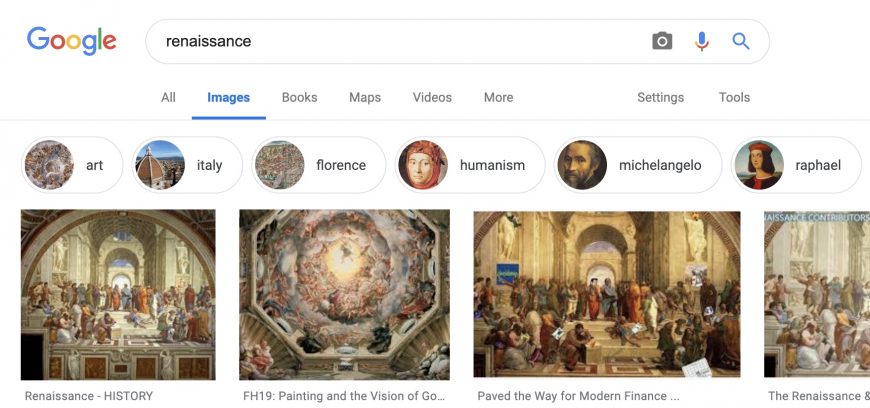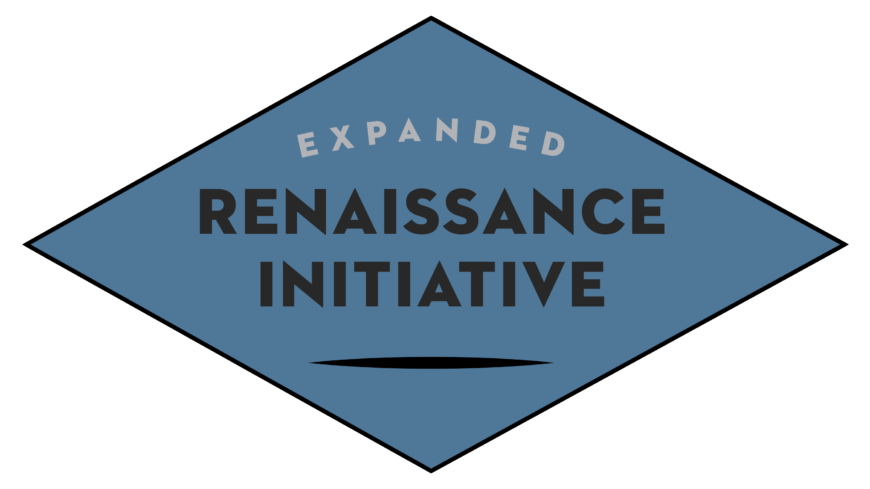If you google the word “Renaissance,” on the image tab, you’ll find yourself exclusively in Italy. Smarthistory would like to do something about that.
The Expanding Renaissance Initiative (ERI) is a Andrew W. Mellon-funded project from Smarthistory (that began in Spring 2019) to expand the boundaries of art history in the classroom—in this case specifically the early modern period. My plan has been to work towards art histories that do not present European art as superior and help to weaken the binary western/non-western paradigm. The ERI is aligned with recent scholarship on what has been called “the global renaissance,” and while I embrace the term “global,” the ERI aims to do more than simply globalize, but to highlight overlooked subjects, materials, artists, groups, and locales.
Disrupting the narrative
The most common narrative of the renaissance in art history focuses mainly on three periods of Florentine art in Italy as presented by Giorgio Vasari, who wrote the Lives of the Most Excellent Painters, Sculptors, and Architects (first published in 1550). Vasari lived in Florence and so naturally celebrated Florentine artists as the best artists of that time. The problem is that many of the artists he praised are the very same artists that continue to receive the most attention in art history today (for example, Giotto, Masaccio, Michelangelo, Raphael). We too often neglect other artists, places, stories, and trends that can reveal a more complex and nuanced era.
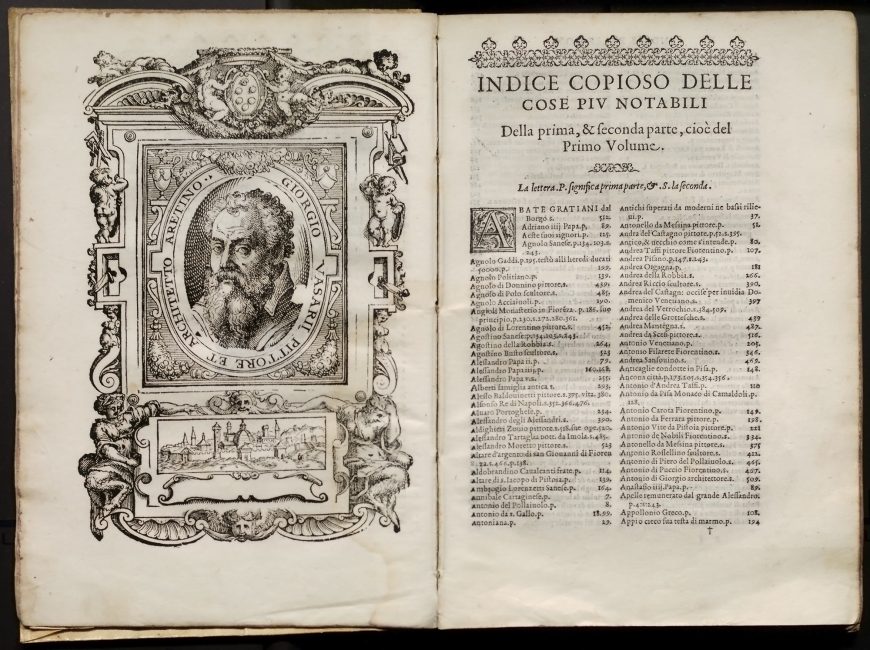
Giorgio Vasari, Le vite de ‘piu eccellenti pittori scultori e architettori (Florence, 1568) (National Gallery of Art)
While one of the ERI’s goals is to decenter Italy as the area with the most important artists and art, we are not saying that there is not important and remarkable art from the Italian Peninsula that speaks to a relationship to the broader world. The point here is simply to note that even as we attempt to shift conversations in the classroom about the renaissance to account for greater cultural pluralism and interactions, it seems important to be mindful of, and examine, other areas as well.
The canon of renaissance art is slow to change. As of 2019, there exists no single textbook that addresses all of European renaissance art. Curiously, the Iberian peninsula (Spain and Portugal) and Ibero-American world remain entirely absent from any current textbook centered on the renaissance era. Even textbooks aimed at “The General Survey” include either nothing or very little about the Iberian Peninsula in chapters on the renaissance—ironically, El Greco (“the Greek” in Spanish), has served to represent all of Spain.
The ERI foregrounds an expanded renaissance world, examining issues of global trade, cultural entanglements, colonization, itinerancy, empire, and gender and racial dynamics between roughly 1330 and 1650, in part to recognize the visual cultures and peoples of Africa, Asia, and the Americas as vital contributors (both willing and unwilling) to renaissance art and culture.
Women artists, Indigenous artists, artwork made of understudied materials such as cochineal, carved gemstones, ceramics, painted alabaster, textiles, featherworks, ceramics, and sculpture made of terracotta, wood, and corn-pith—all speak to the vibrancy and challenges of this broader renaissance. Rather than focusing primarily on only “high art,” new content will continue to highlight “key players in this new, globally connected practice of art history.” [1] The majority of such works are non-canonical, often forms that belong to large, influential genres and so are critically important to our understanding of the global renaissance. These works reveal fascinating stories about the renaissance world that would otherwise be lost to us.
The global renaissance?
Since the 2002 publication of Jerry Brotton’s The Renaissance Bazaar spurred greater interest in “The Global Renaissance,” there have been scholarly disputes about the usefulness of the idea of a global renaissance, and the best ways to approach it. Scholars have argued the extent to which cross-cultural contact occurred and the extent to which it transformed people’s lives and artistic production. However, even as interest in the global renaissance has grown, publications and exhibitions have, for the most part, remained Italo-centric, favoring especially Venice’s relationship with “the East.”
Recently, art historian Lia Markey has found that the global renaissance has not “significantly affect [ed] or alter [ed] teaching, the conception of the canon, or the permanent museum display.” [2] Still, many scholars continue to push the limits of the renaissance to “decenter the insularity of the Vasarian Renaissance,” as a way to challenge traditional narratives, ask new questions, and confront entrenched biases about renaissance art, and the field of art history more broadly.
A number of questions need to be asked: must all renaissance art history trumpet the achievements of famed artists such as Masaccio, Donatello, Leonardo, Michelangelo, Raphael, and Titian; or the Northern artists van Eyck, Dürer, Holbein, etc.? Can scholars allow themselves the freedom to center other narratives that reveal important facets of this period without always celebrating European male artistic genius? In what ways can a globalized renaissance art history directly confront ongoing issues of bias, discrimination, or racism in the field of art history? In the words of Claire Farago, “the geographical, cultural, chronological, and conceptual boundaries of the Renaissance as it is usually defined need to be redrawn” [3]. And not just in scholarship, museums, or renaissance art courses, but in general survey classes and beyond the borders of the Academy as well.
Visual entanglements
In 1604, the poet Bernardo de Balbuena wrote about Mexico City that “In thee Spain and China meet, Italy is linked with Japan, and now, finally, a world united in order and agreement.” [4] He wrote that Mexico City, capital of the viceroyalty of New Spain , had become a cosmopolitan linchpin between Asia and Europe, prospering as a result of a global trade system. Recent museum exhibitions (Made in the Americas: The New World Discovers Asia (MFA, Boston), Contested Visions in the Spanish Colonial World (LACMA) and Painted in Mexico, 1700–90: Pinxit Mexici (LACMA, The Met)) have focused on this transcultural exchange, offering visually captivating objects that attest to the impact of cultural interchange.
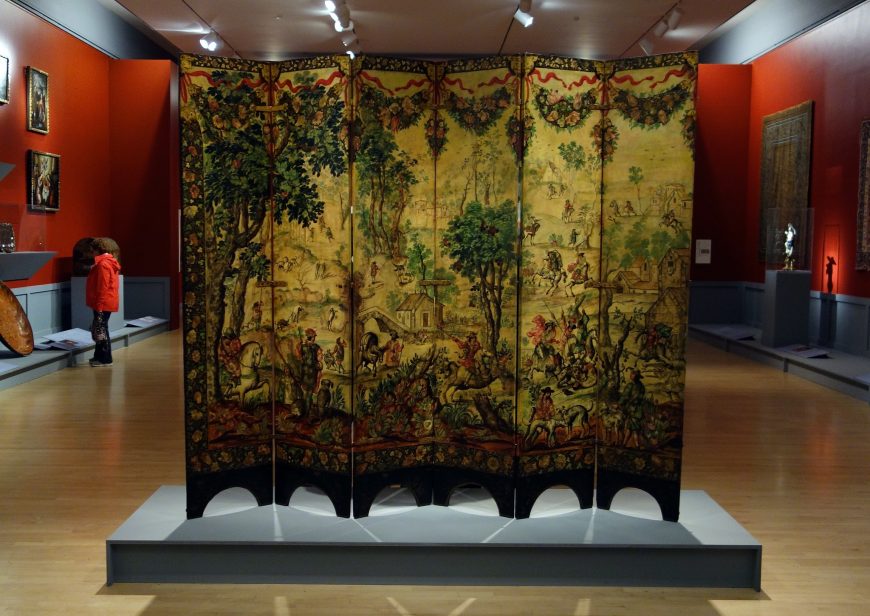
Folding Screen with the Siege of Belgrade (front) and Hunting Scene (reverse), c. 1697-1701, Mexico, oil on wood, inlaid with mother-of-pearl, 229.9 x 275.8 cm (Brooklyn Museum)
Clearly, global trade had made Mexico City a cosmopolitan center, but at what cost? Many publications and exhibitions use the words “exchange” and “cross-cultural exchange,” in a celebratory sense that seeks to unseat the idea that global travel and communication belong only to the 20th and 21st centuries, but can these terms adequately encapsulate the impact on the many peoples and cultures then coming into contact? Exchanges were not necessarily mutually beneficial, many were forced and fraught with violence. How then do we treat objects that result from violence? How do we discuss and categorize them? Should we use the stylistic categories we use for European art such as the renaissance, even if it marginalizes work that often exists in-between such categories? How do we not merely westernize world art history? I believe that the ERI has the potential to address some of these questions, to ignite conversations, and offer a model for how we can shift problematic, yet deeply ingrained classroom narratives.
My aim with the ERI is to reframe the renaissance to help students to discover that there is more that is important than Michelangelo’s David and Leonardo’s Mona Lisa. I hope to prompt further reflection on Sanjay Subrahmanyan’s suggestion that it is “good to think globally in order to redefine the possible objects of historical study.” [5] I also hope to prompt consideration of what is at stake in such a reframing, and what it means to decolonize renaissance art history, addressing the issue of not only content coverage, but also who gets to stand “behind the podium” to advance our knowledge of what is or isn’t renaissance art (this issue has been raised by Dr Ananda Cohen-Aponte (@drnandico) on Twitter, in a discussion of #pocarthistory).
Many of the objects that we have focused on so far speak to the mobility of things, people, and ideas in the early modern period, while also demonstrating the visual entanglements occurring as a result of globalization, colonization, and more. Networks of trade-connected ports, and markets functioned as nodes where objects were gathered, stored, and dispersed. Much of this globalization was the result of European colonization. And so armies were often followed by Christian missionaries who brought with them objects that played an important role in the development of transcultural art forms.
There were, of course, also countless artists who worked in these newly colonized regions, although their names often remain unknown to us. These artists drew on their own artistic traditions and cultural ideas while producing art and architecture. Some objects have visible artistic entanglements, while others do not. It is important that we address how colonized peoples borrowed, adapted, and rejected European forms, subject matter, and ideas (often forced on them), and what these choices might mean for our understanding of renaissance art. The black-and-white murals at the convent of San Agustín, Acolman, Mexico (c. 1560–90), painted by currently unknown Indigenous artists, demonstrate a visual entanglement of artistic traditions from Central Mexico, Flanders, Italy, and Spain. They speak to the flexibility and the mobility of forms as they infiltrated colonized regions around the world. The murals of Acolman complicate the narrow definition of renaissance art we have clung to for too long.
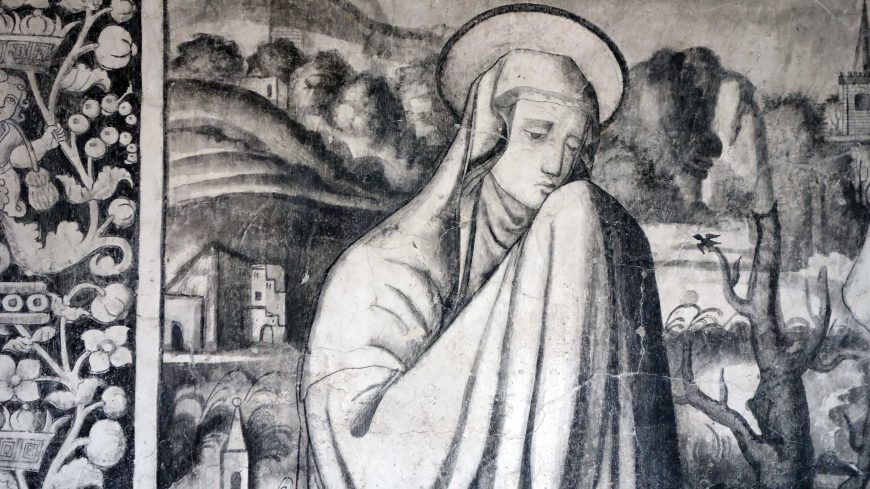
Virgin Mary (detail), Crucifixion , San Agustín de Acolman murals, c. 1560-90, large cloister of the Ex Convento of San Agustín de Acolman, Mexico (photo: Dr. Steven Zucker, CC BY-NC-SA 2.0)
The words we use
Intercultural objects like the murals at Acolman encourage us to critique commonly used terminology. We frequently hear phrases and terms like “Old World” and “New World” to describe Europe and the Americas, or the “Age of Discovery” or “Age of Exploration” to describe the fifteenth and sixteenth centuries. But who do these terms privilege? To say “the New World” privileges the perspective of Europeans—after all, the Americas were only “new” to them. “Old World” suggests a place more ancient, with more history, and it ignores the complex, unique, and varied histories of many Indigenous peoples across the Americas, as if they only really matter once Europe arrives to make them “new.” Similarly, it may have been an era of discovery for Europeans, but it was often a period of trauma for the many peoples around the globe who were “discovered.” The essays or videos created for the ERI speak to these issues and offer different objects for study, such as a Nahua featherwork or a Philippine ivory sculpture, as well as different perspectives about the renaissance more generally.
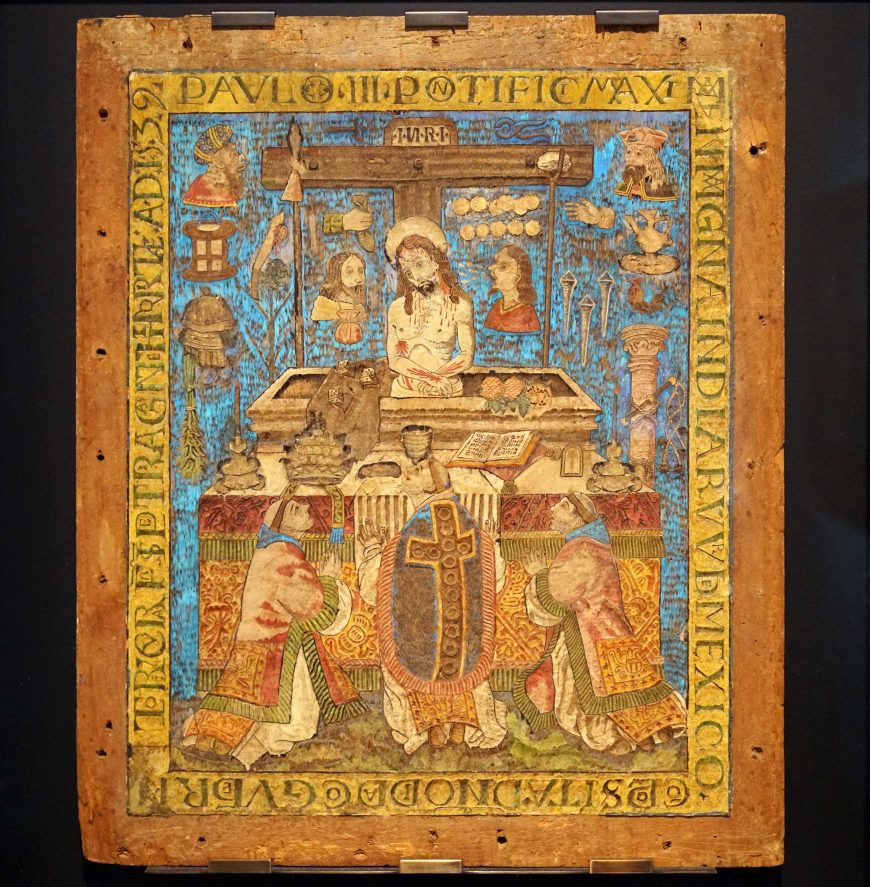
The Mass of St. Gregory (detail), 1539, feathers on wood with touches of paint, 26 1/4 x 22 inches / 68 x 56 cm (Musee des Jacobins)
What’s coming with the ERI
This initiative has unfolded over several years (and will continue to unfold), and currently includes essays about cabinets of curiosities and collecting practices of the Medici family, Theodore de Bry’s early engravings of the Americas, portraits of the female author Christine de Pizan, and the relationship between Spanish and Flemish painters in the fifteenth century. A more complete list of essays and videos that relate to the ERI can be found as a short course.
I also want to encourage materials that reframe canonical artworks, examining them from different vantage points. For example, we now have an essay that reframes Hans Holbein’s The Ambassadors, specifically considering what the painting tells us about the globalized world at the time of its creation. Another essay examines Gentile da Fabriano’s Adoration of the Magi through a similar lens, investigating what the psuedo-Arabic, painted silks and brocades, lapis lazuli, turbaned figures, and non-European animals tell us about this era.
An art history survey class could foreground how the period between 1400 and 1650 “was intensely, often violently, cross-cultural.”[6] Using materials largely drawn from Smarthistory, students could engage with and contextualize Netherlandish painter Hugo van der Goes’s Portinari Altarpiece and Florentine artists responses to it, Dürer’s Rhinoceros woodcut, a Medici blue-and-white porcelain, a Mexican featherwork and convento mural program, Felipe Guaman Poma de Ayala’s 1200-page illustrated letter to the Spanish king, a Benin brass plaque of an oba, or a Sapi ivory salt-cellar sold to the Portuguese.
For some of these materials, teachers will find materials that help introduce these materials into existing curriculum. My hope is that the ERI will energize discussions of what renaissance art is, making it more relevant to our twenty-first century students.
Notes:
2. Lia Markey, “Global Renaissance Art: Classroom, Academy, Museum, Canon,” in The Globalization of Renaissance Art: A Critical Review, edited by Daniel Savoy (Leiden: Koninklijke Brill), p. 260.
3. Claire Farago, “The Concept of the Renaissance Today: What is at Stake?” in Renaissance Theory, edited by James Elkins, Robert Williams (New York: Routledge, 2008), p. 71.
4. Bernardo de Balbuena: La grandeza mexicana y compendio apologético en alabanza de la poesía (Mexico City: Porrúa, 1975).
6. Dana Leibsohn, “Introduction: Geographies of Sight,” in Seeing Across Cultures in the Early Modern World, ed. Dana Leibsohn and Jeanette Favrot Peterson (London: Routledge, 2012), p. 2.
Additional resources:
Check out the short course that includes materials relevant to the ERI.
Jerry Brotton, The Renaissance Bazaar (Oxford University Press, 2002)
Jeanette Peterson, “Renaissance: A Kaleidoscopic View from the Spanish Americas,” in Renaissance Theory , ed. James Elkins and Robert Williams (New York & London: Routledge, 2008)
Ananda Cohen-Aponte, “Decolonizing the Global Renaissance: A View from the Andes,” in The Globalization of Renaissance Art: A Critical Review , ed. Daniel Savoy (Leiden: Brill, 2017)
Dana Leibsohn, “Introduction: Geographies of Sight,” in Seeing Across Cultures in the Early Modern World, ed. Dana Leibsohn and Jeanette Favrot Peterson (London: Routledge, 2012)

